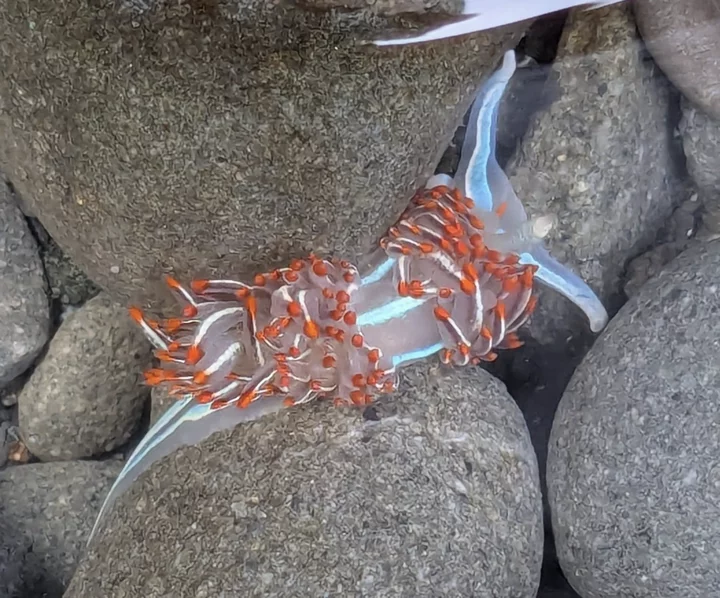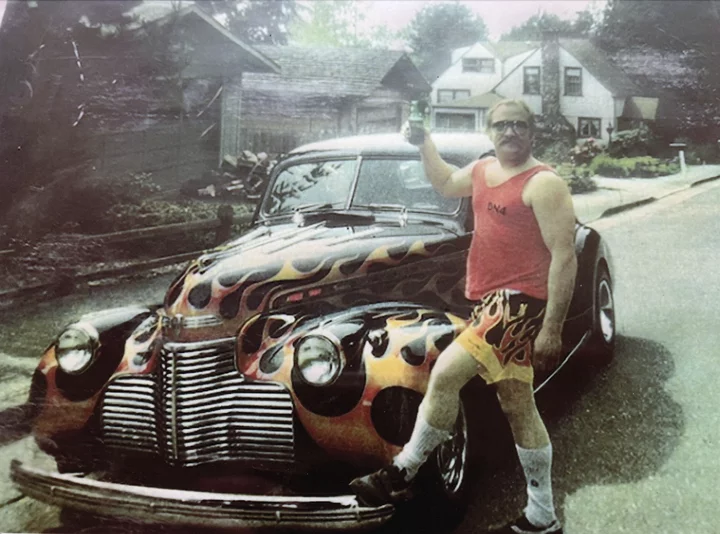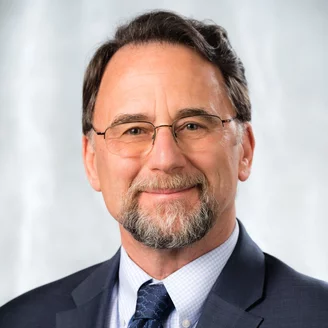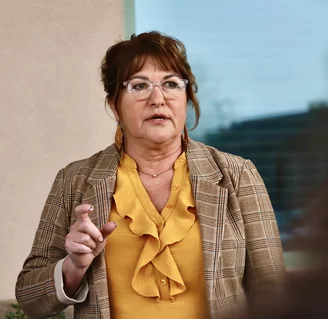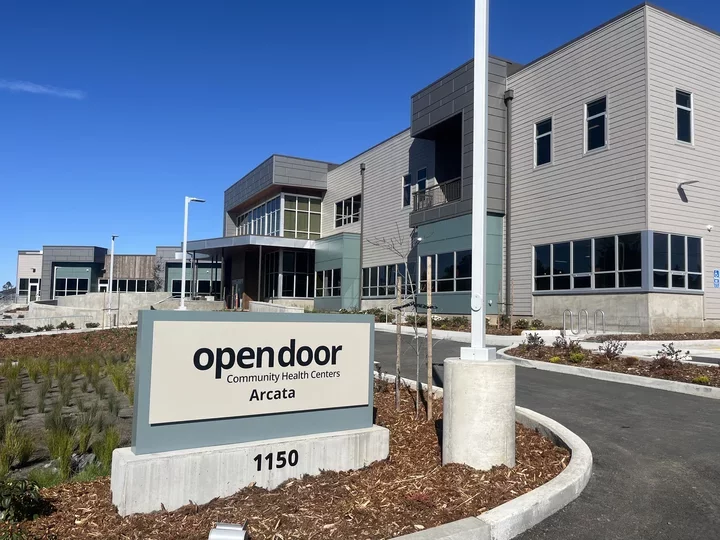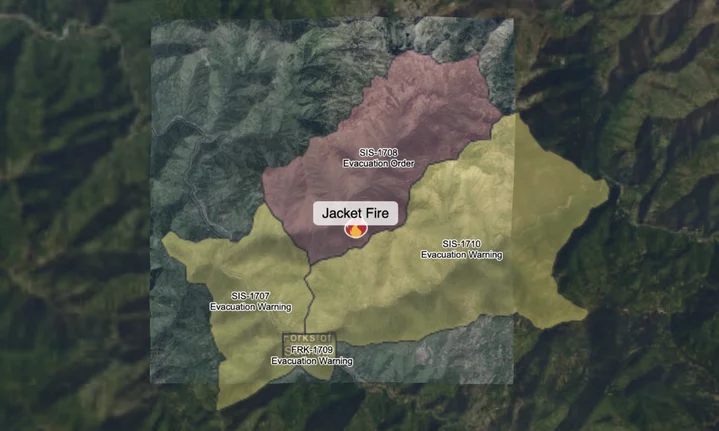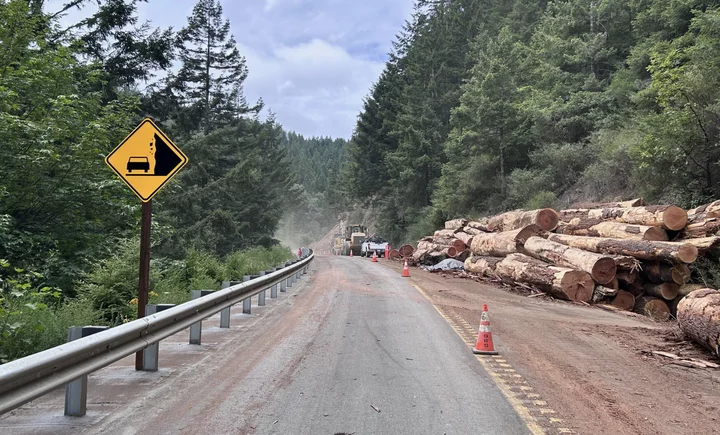THE ECONEWS REPORT: Potholes in the Forest Service Roadless Rule
The EcoNews Report / Today @ 10 a.m. / Environment
Image: Klamath National Forest
###
The Trump Administration has announced it seeks to revoke the “Roadless Rule,” the 2001 regulation limiting U.S. Forest Service activities in unroaded areas of our National Forests. Guests Kimberly Baker of the Environmental Protection Information Center (EPIC) and Scott Greacen of Friends of the Eel River join the program to discuss the history and purpose behind defending roadless areas and what this new attack on our public lands means for clean water, fish and wildlife, and recreation.
More information on the history of the Roadless Rule can be found here.
###
BOOKED
Today: 6 felonies, 14 misdemeanors, 0 infractions
JUDGED
Humboldt County Superior Court Calendar: Today
CHP REPORTS
1500 Mm36 E Hum 15.00 (HM office): Assist with Construction
ELSEWHERE
Times-Standard : Civic calendar | Twice-delayed Eureka Avelo discussion again on agenda
Times-Standard : Sexual assault attempt reported at Sequoia Park; suspect, described as teenager, is at large
RHBB: Airport Fire Ignites Near Hoopa Late Friday Night
RHBB: Tensions Rise at July 4th Protest Outside Humboldt Courthouse Amid National “Free America” Movement
(VIDEO) TIMELINE CLEANSE: Local Woman Spots Beautiful Sea Creature Near Trinidad
Andrew Goff / Yesterday @ 8 a.m. / Wildlife
Photos/video: Brandi Barbee
It’s so rare you come across something online that’s just pleasant these days. But such was the case when we happened upon a post by Brandi Barbee who was lucky enough to spot a brightly colored thick-horned nudibranch crawling through the tide pools near Trinidad earlier this week.
“It was an awesome experience and we’re so lucky to have such incredible biodiversity,” Barbee told us.
Agreed! Look at this thing!
Awww.
OBITUARY: John ‘The Muff’ Peterson, 1946-2025
LoCO Staff / Yesterday @ 6:56 a.m. / Obits
Sadly, John lost his battle with cancer on June 20th, 2025. A “big kid” at heart, he wanted to have fun and bring others along for the ride—what a ride it was!
Born in October, 1946, in Eureka, Calif., this rambunctious guy hit the ground running! Always a hard-working man, he began in high school first working for Purity Grocery, various gas stations and Safeway. This led to Sacchi Chevrolet where he began his passion of working with cars.
Dawn of The Muff
In 1971 he opened his own business: Arcata Muffler. John diligently held the sunny top corner of the Arcata Plaza for 34 years. John’s customers ran the gamut: hot-rods, first-time car owners, seasoned drivers, local businesses, farmers, professors, and even Monster Truck the Cardiff Giant.
Over time his shop became a hub for the local car culture in the area as John inspired countless car enthusiasts to “Just give it a little more ROAR!” Driving past was a treat for locals to see what was being worked on. Always helpful, willing to lend a hand, and cracking jokes, he made certain that anyone coming to his shop would leave with a safe and solid solution for their car and a smile on their face. “Well, you simply can’t just hold that up with bailing wire … Let’s see what we can do for you.” John understood that not everyone could afford his services, so he was always willing to work with them on the price. Grateful customers would often tip with a cold beverage, which he didn’t seem to mind.
A Community Booster
Supporting local businesses and forging friendships with the owners, John was revered by many and enjoyed boosting the spirit in others.
John participated and sponsored many local events, lending his talents, time, and spirit. Some of note include:
- The Kinetic Sculpture Race: Welding and repairing machines on the road
- Arcata Bar Stool Races: Building/racing motorized bar stools on the Plaza
- Arcata Muffler Baseball Team: Founder
- Redwood Park Lunch Box Derby: Building cars, planes, and racers out of lunch boxes and racing them down the Stump Slides.
Custom Car World
John had a passion for the car scene and the community it builds. Restoring some and creating street rods out of many, his hobby also forged lifelong friends with so many great people. These family-based activities held so many fun memories of the good times all had on the road traveling, often driving show cars to the shows. His love for old cars and an interest keeping them on the road gained him quick notoriety and every car he built was published in a magazine.
One of Muff’s earlier builds was a 1930 Model A Ford he used for his Arcata Muffler Logo. Going on to build more street rods, his final build was a 1948 Studebaker pickup. This eye-catching machine made the Feb. 2007 cover of Street Scene Magazine, calendars, and various car magazines, all of which he was very proud of. He also added his Studebaker into another logo for his shop.
An active member of the local car seen, he and his wife Judy towed the D.A.R.E. Police car to Las Vegas for the SEMA Show where they received a lot accolade, both enjoyed the trip and special opportunity. Later that year, Judy’s father, James Ulmer, passed away and left them his 1957 Ford. The Arcata Police Department was just starting up a new program “Citizens on Patrol.“ Inspiration struck: With donation from Local Businesses, and private donors, the ’57 Ford was transformed into a beautiful Arcata Police cruiser for local parades and events.
A Man of Many Talents
John was always active in many fields: He bought and sold antiques, finding some real treasures at times. Passionate for restoration, he enjoyed restoring antique gas pumps and did a beautiful job bringing them back to new.
A Lifelong Love:
In the little town of Phillipsville, Ca. while staying at the Deerhorn Lodge John met his later to be Wife Judy. He was 14 and she was 12. His parents had a small travel trailer and she would see him in the summer months. Frolicking in the pool, cabins and running in the campground, they always looked forward to seeing one another. In 1966 Judy moved up to Eureka for school. She called John’s Mother Mary to inquire about him and was told that he was in the Army National Guard Boot Camp in Georgia. Mary gave Judy his address and a pen-pal relationship was formed. They wrote many letters while he was away. Upon his return, she was happy to seem in again and as the story goes, he was happy to see her too. They were married two years later and began to build a Family.
John is survived by his Wife of 57 years Judy, his two Sons and their families - Gary Peterson and Shelia, Dennis Peterson, and Megan. 6 Grandchildren, 2 Great Grandchildren, 3 Nieces, 1 Nephew and their families, along with countless friends and rebellious machines on the road.
Letter: Childhood friend: Mark Woods – Surprise Ariz.
“John was an industrious, talented individual putting those attributes to work to develop and manage a highly successful business. He was a superb mechanic, muffler/exhaust system magician/consummate barstool racer. He had a keen eye for collecting/refurbishing those bits and pieces of cherished childhood memorabilia. We both shared a deep affection for our hometown of Arcata: Quiet, but vibrant place in the redwoods that gave us a wonderful childhood: enriching us with lifelong friendships and precious memories. He was an honest, generous, no-nonsense man with a sharp sense of humor and welcoming demeanor. The world is just a little bit dimmer in his absence, but I will always muster a smile whenever I think of him, which will be often. It was truly an honor having John as friend.”
Per John’s request: there will not be a formal service.
“NO MUFF TOO TOUGH!”
‘Devastating’: Local Health Care Leaders and Organizations React to the Passage of Trump’s Big Bill
Ryan Burns / Thursday, July 3 @ 4:39 p.m. / D.C. , Health Care , Local Government
With today’s narrow passage by the U.S. House of Representatives of H.R. 1, President Donald Trump’s multitrillion-dollar package of tax cuts and spending, the president’s so-called “One Big, Beautiful Bill” awaits only his own signature before becoming law.
Among its many projected impacts — which include adding at least $3.3 trillion to the nation’s debt over the next decade — the bill is expected to have a dramatic impact on the nation’s health care. It includes sweeping cuts to Medicaid that are projected to result in 8.7 million people losing Medicaid coverage and 7.6 million people losing insurance altogether over 10 years, according to initial estimates from the nonpartisan Congressional Budget Office.
The Outpost reached out to several local organizations and health care professionals in hopes of getting a better understanding of what the local impacts could be. We spoke with Tory Starr, the chief executive officer of Open Door Community Health Centers, and received statements from Connie Beck, director of the Humboldt County Department of Health and Human Services, as well as Providence Health & Services, Partnership HealthPlan and the County Welfare Directors Association.
Requests for comment from SoHum Health, Mad River Community Hospital and the K’ima:w Medical Center were not returned by the time of this post’s publication.
Starr was the only person we were able to speak with at length. He said that with approximately one third of all Californians covered by Medi-Cal (the state’s version of Medicaid), the impacts across the state will be significant.
Open Door is the largest provider of obstetrics and primary care in both Humboldt and Del Norte counties, and Starr said that a little over half of the organization’s patients are on Medi-Cal.
“Because we’re in a rural area, many other practices in the community over time have closed,” he said. “There’s not many of us left doing this work.”
While Starr believes the health care consequences of Trump’s bill will be profoundly negative, he described the contents of the legislation as “fairly ingenious.”
“Republicans tried to repeal Obamacare [the Affordable Care Act] the first time Trump was in office; this time they got smarter,” Starr said. “Now they’re just defunding it. So they learned their lesson, and they’ve done a really good job because they say they’re not cutting any benefits but what they’re doing is making it really hard for people to access them. It’s pretty ingenious and disturbing.”
By way of example, Starr said the bill will require people to apply for Medi-Cal twice per year instead of just once — “and if you’ve ever filled out any government forms, you know it’s not easy,” he said.
Those applications will have to be processed by counties and then sent on to the state for approval — “so you just doubled the workload for the county and state during times of shrinking budgets,” Starr explained.
Beck confirmed this in her statement while also noting the additional requirements people will face to qualify for Medi-Cal coverage, including stricter work requirements and income eligibility:
This is a tremendous cost-shift to states and counties. We’re going to have to stand up whole new systems to verify that people are working at least 80 hours a month to keep their Medi-Cal coverage, as well as verify income eligibility every six months, instead of annually.
These changes will start January 2027. Just under a year and half from now, and there’s only $100 million in grants to states included in the bill for this new workload. To give you some perspective, Georgia spent $50 million on upgrading their IT systems to implement their Medicaid work requirements. So, this is a big hole in the state budget.
Locally, 58,000 people are enrolled in Medi-Cal and about 24,000 will be subject to these new requirements.
The bill also increases the state and county share of administrative costs for CalFresh, which will have a significant impact on state and county budgets. More people will be subject to work requirements for CalFresh benefits too. This will also increase county workload and costs.
I’m afraid that a lot of Humboldt County residents are going to lose Medi-Cal and CalFresh benefits. Not because they’re not working — most are — but because the rules for documenting that work or getting an exemption will be hard to follow. This is a big step backward for our organization’s mission to reduce poverty.
Starr said Republicans justified the stricter eligibility and income rules through oft-repeated messaging about “fraud, waste and abuse,” which he described as misleading but “very politically astute.”
“The vast majority of folks who are served by Open Door and on Medi-Cal are working already, so it’s disingenuous to suggest that all these people are fraudulently freeloading on Medi-Cal or Medicaid,” Starr said. “Other folks have bona fide disabilities or they’re moms with kids. [Politicians] say [such people] won’t get kick off, but they will make them jump through more hoops to stay on, which will result in many not meeting deadlines. They [the politicians] know that’s a way to reduce cost by creating barriers to access.”
Any system as large as the U.S. health care industry — estimated at $4.9 trillion in 2023 — will inevitably have examples of waste and abuse, Starr allowed. But he said the biggest examples come not from patients but from large private insurance companies that require prior authorization for coverage of many procedures and make a practice of denying coverage and forcing customers to appeal.
“That’s waste,” he said. “There’s nothing value-added.”
As for abuse and fraud, it mostly comes from the commercial side of the industry, including medical supply contractors, rather than government programs, Starr said, noting that Medicaid only uses three cents of every dollar on administrative costs while private insurers spend more like 10 to 20 cents per dollar.
“It costs a lot to deny and slow down claims and get prior authorization,” he said.
Like Beck, Starr pointed to the fact that most of the changes enacted by this bill won’t take full effect until late 2026 or later, which is after next year’s mid-term elections. He’s worried that voters’ attention spans won’t last long enough to hold the Legislature responsible for the impacts of this bill, especially since the most severe consequences won’t be felt for years.
“People forget that it was the Affordable Care Act that standardized insurance policies and said that if you want to sell them in the United States … you can’t kick people off or not give them insurance if they have preexisting condition, and you can’t kick kids off until they’re 26,” Starr said.
He believes that Trump’s big bill will take America back to what the country had before the ACA, with potentially millions of people lacking any health care coverage.
“We’re the richest nation on the planet,” he said. “We can afford to provide health care to our citizens. We’re the only industrialized nation that does not do that.”
As a federally qualified health center, Open Door is required to care for people even if they can’t pay for services, or can only pay a small portion via the clinic’s sliding scale. Starr said administrators are concerned but they’re also working to ensure that their patients retain their insurance coverage if at all possible by communicating with them about when they need to re-apply or submit documentation for working or volunteering.
“It’s a long haul,” he said. “We will need to make sure people understand that. This is just the beginning of a really long journey until we get back to some sense of — I don’t know what to call it anymore — normalcy? It’s hard to say.”
Providence emailed a statement on Wednesday, after the Senate had barely passed the bill but before the House had done so. Here’s that statement:
The Senate’s passage of H.R.1 includes deep and devastating cuts to Medicaid, which would destabilize hospitals and providers across the country and place access to vital health care services at risk.
If the House passes the bill in its current form, more than 11 million individuals will lose access to health care. Additionally, reducing funding for Medicaid by nearly $1 trillion over the next 10 years will impact every patient. These far-reaching funding reductions will limit health services; lead to care delays and longer wait times, especially in emergency departments; and place undue strain on overburdened health care providers.
Grounded in our Mission, Providence will continue to advocate for the preservation of Medicaid, and we urge lawmakers to recognize the integral role Medicaid plays in maintaining health care access across our communities.
The organization also endorsed this statement from the Catholic Health Association of the United States, which describes the bill as “a moral failure” that will inflict “deep harm on essential community health and social safety-net programs, threatening the survival of rural hospitals and long-term care facilities.”
Meanwhile, the County Welfare Directors Association (CWDA) described Trump’s signature domestic legislative achievement as “an unprecedented assault on millions of Americans.” The organization’s executive director, Carlos Marquez III, released the following statement:
County human services officials who devote their life’s work to keeping vulnerable families and individuals safe, healthy, housed, and fed are dismayed by the passage of H.R.1 and the overnight dismantling of California’s safety net as we know it. The human suffering and societal costs this legislation will wrought are nearly incalculable, except that Congress and the White House had full knowledge of its unconscionable impacts and chose to wage a war on the poor and working poor anyway – over 700,000 low-income Californians may go hungry, up to 3.4 million will now be at risk of losing their healthcare.
Counties will endeavor to continue our role as an indispensable backstop against unmitigated sickness and poverty, to ensure children have the nutrition and healthcare they need to go to school and parents to work, but we cannot weather this deeply uncertain moment alone. We stand ready to work with the Governor and Legislature to deliver on our mission now more than ever.
Lastly, here’s a statement from Partnership HealthPlan of California, the nonprofit that contracts with the state to administer Medi-Cal benefits through local care providers to recipients in two dozen counties, including Humboldt:
Medicaid has been the cornerstone of America’s health care promise — delivering critical services that transform lives and ensure essential health care remains within reach, from rural communities to suburban neighborhoods.
For more than 30 years, Partnership HealthPlan of California has been committed to ensuring access to quality health care for our most vulnerable community members. This week, Congress and the president made $1 trillion in Medicaid cuts that will impact our members, along with the entire Medi-Cal program.
In Partnership’s 24 counties, Medicaid is an economic engine, helping to fuel the small business workforce with reliable health coverage, keeping emergency rooms open 24/7, and supporting nurses and doctors who choose to practice throughout our service area.
Our commitment to the members we serve remains unwavering. Partnership’s members can be assured that we are dedicated to finding solutions to maintain and support their health and the providers who care for them.
Our mission to serve California’s safety net population continues, and we will meet this challenge the same way we always have — by working together.
Open Door’s Arcata clinic. | File photo.
Jacket Fire Prompts Evacuations Near Forks of Salmon in Siskiyou County
Isabella Vanderheiden / Thursday, July 3 @ 3:45 p.m. / Fire
Screenshot of the approximate CalFire’s evacuation map for the Jacket Fire in Siskiyou County.
###
A new wildfire burning near the Humboldt-Siskiyou County line has burned roughly 17 acres of forest along Yellow Jacket Ridge, prompting evacuations for people living along Salmon River and Sawyers Bar roads, near Forks of Salmon.
The Jacket Fire ignited just before 9 o’clock this morning. As of Thursday afternoon, the fire is zero percent contained. The cause of the fire is under investigation.
Siskiyou County has issued a mandatory evacuation order for SIS-1708 and evacuation warnings for SIS-1707, SIS-1710 and SIS-1709. A detailed, interactive map of the current evacuation warning can be found at this link.
“Resources continue to arrive on the Jacket Fire, which has been mapped at 17 acres with a moderate rate of spread,” according to a Facebook post from the Klamath National Forest. “Air support has been key in reducing fire growth while dozers, hand crews, and engines gain access to the fire. Fire retardant has effectively slowed fire growth.”
Evacuation information and updates can be found on the Siskiyou County Sheriff’s Office and Klamath National Forest Facebook pages — linked here and here.
HIGHWAY 36 OPEN: You May Now Enjoy the Freedom of East to West Movement Once Again
LoCO Staff / Thursday, July 3 @ 2:47 p.m. / Traffic
Oh, the places you’ll go | Caltrans
Caltrans release:
Route 36 is now open to one-way traffic east of Swimmer’s Delight near Grizzly Creek Redwoods State Park. Travelers should be prepared for delays and drive through the slide area with caution. CHP may be present to assist with traffic flow.
Even over the holiday weekend, when no active construction is scheduled, vehicles will be escorted through the area in small groups for safety. Delays will depend on traffic volumes and are difficult to predict, but 30 minutes is a reasonable estimate.
Starting the week of July 7, crews will begin constructing a temporary lane farther from the hillside, along with other stabilization work in the area. During this period, drivers should prepare for longer weekday delays and plan trips accordingly.
Local Man Hospitalized After Trying to Help a Severely Injured Black Bear That He Struck With His Vehicle on Highway 299
Isabella Vanderheiden / Thursday, July 3 @ 1:49 p.m. / Traffic
WARNING: Graphic image of a severely injured animal below.
###
A 59-year-old Salyer resident was hospitalized on Sunday after an encounter with a “severely” injured black bear at Berry Summit on Route 299.
The man, who has not been publicly identified, struck the 400-pound male bear with his vehicle just before 11 a.m. on Sunday, according to California Highway Patrol (CHP) incident logs. He quickly got out of his vehicle to help the injured animal over the nearby guardrail and was bitten several times.
“After striking the bear and seeing that it was severely injured, the motorist felt bad about it, stopped his vehicle, and got out to see if he could help the bear,” Peter Tira, a public information officer with the California Department of Fish and Wildlife (CDFW), told the Outpost. “Mortally wounded, the bear was struggling to climb over a guardrail on the highway and get back to wild habitat on the other side apparently. The motorist tried to assist by helping the bear over the guard rail and was bitten in the process.”
The bear died shortly thereafter, Tira said.
CHP Sgt. Caleb Carsey told SFGATE‘s Amanda Bartlett that the Humboldt Area CHP office was “flooded with 911 calls” after the incident. Several witnesses looked on as the 59-year-old man approached the bear and was bitten “multiple times in his left forearm,” Carsey told SFGATE. An off-duty EMT who witnessed the incident responded immediately and applied a tourniquet to the injured man’s arm before calling Trinity Life Support ambulance.
The man was taken to a local hospital to be treated for his injuries, though his current condition is unknown. The CHP has not yet responded to the Outpost’s request for additional information.
Tira took the opportunity to remind drivers to watch out for animals while traveling the roads this summer and to take extra precautions when driving around dawn and dusk when wildlife is more active.
“Late spring and summer are always a very busy time for bear activity across California [because] it is mating [season] for black bears,” he continued. “If there’s a lesson here, it’s never to handle or approach a wild animal, particularly a wounded wild animal as they feel threatened, obviously, and in fear for their life, and are dangerous and unpredictable in that state.”
###
Photo submitted by Samantha Minton.



